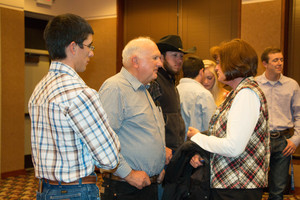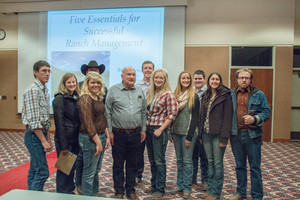Teichert speaks on Five Essentials for Successful Ranch Management

Burke Teichert, a ranch management speaker and consultant who managed the Rex Ranch near Hyannis for about two decades, spoke to about 50 local ranchers and 10 Chadron State College students Friday night in the CSC Student Center.
Teichert made the presentation during the last of eight stops in a lecture tour around the state of Nebraska sponsored by the Nebraska Grazing Coalition and the University of Nebraska-Lincoln Extension Service.
He reviewed principles that he has distilled from a lifetime of ranch management into a program he calls Five Essentials for Successful Ranch Management.
CSC students from Ron Bolze's agriculture courses and other students attended the event. Bolze works closely with the Nebraska Grazing Coalition.
“Being able to listen to Burke speak again was a great experience. As the daughter of one of his former colleagues, it means a lot to hear his methods of management,” said Brandi Bailey of Lakeside, Nebraska.
People, both on off the ranch, are a major component in Teichert's success formula. He encouraged those in attendance to build positive relationships with veterinarians, feed dealers, suppliers, neighbors and others. If this is done well, these advocates can become unpaid members of the ranch manager’s team, Teichert said.
Winning over hired personnel is another important factor.
“You want the hearts and minds of your employees, not just their arms, legs and eight hours a day,” Teichert said.
Minimizing the amount of equipment and its related costs is an additional principle.
“Most ranches have too much stuff, stuff that rusts, rots or depreciates. Any time you can eliminate a machine between a cow and her feed, you’ve decreased your overhead. Let the cow be the harvester. Increase grazing days and decrease fed feed days,” he said.
Teichert touched on non-traditional grazing techniques such as a moving a herd of cattle into a smaller pasture for a short time with the intention of letting their hoof action add nutrients to the soil. He said in this approach, the cattle will need time to adjust to being moved from one pasture to another frequently, being closer to one another and seeing fresh feed more often. He pointed out that the herd should only take up a small portion of the overall ranch.
“There’s a learning curve for both people and animals,” he said.
In addition to pointers on building thoughtful grazing plans, Teichert addressed the necessity to cull unproductive or high maintenance animals.
“If you have to pamper a bull, you don’t want his daughters. You want animals that can adapt to and withstand the worst conditions in your region,” Teichert said.
Teichert praised the benefits of cross-breeding while also warning against drastic interference with genetics which can cause unintended consequences. As an example, he cited dairy cows that produce extremely high levels of milk, but become nearly infertile through the genetic selection process.
In another example of balance, he said that even though computerized records are important, especially for large operations, a visual ear notching system tells him, at a glance, the status of a cow. One notch means, based her past performance, she will never be the mother of a bull and a second notch means she will be culled from the herd.
Low-cost producers who follow this and other similar advice, can weather tough times, according to Teichert.
During the four-hour program, which included dinner, Teichert covered multiple factors which make a ranch profitable, including a non-winter calving season, developing a drought plan and a heavy snow plan and other aspects involved in a holistic ranching and grazing approach.
“You can’t just think in one dimension, you have to anticipate and consider the intended and unintended consequences of your decisions,” he said.
Category: Campus Events, Campus News, Range Management


